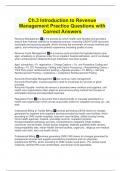Ch.3 Introduction to Revenue Management Practice Questions with Correct Answers Revenue Management ✅is the process by which health care facilities and providers ensure their financial viability by increasing revenue, imrpvoing CASH FLOW (accounts receivable and accounts payable, which involves the movement of money received and spent), and enhancing the patient's experience (including quality of care) Revenue Cycle Management ✅is a revenue cycle process that typically begins upon appt. scheduling or physician order for an inpatient hospital admission, and it concludes when reimbursement obtained through collections has been posted. Appt. scheduling > Pt. registration > Charge Capture > Dx. and Procedure Coding and Auditing > Pt. D/C Processing > Billing and Claims Processing > Resubmitting Claims > Third Party payer reimbursement posting > Appeals process > Pt. Billing > Self pay Reimbursement Posting > Collections > Collections Reimbursement Posting Accounts Receivable Management ✅aka revenue cycle management Accounts Receivable - involves payment owed to a business for services or good provided. Accounts Payable - involves the amount a business owes creditors and suppliers, and health care organizations often adopt an accrual accounting method that focuses on anticipated revenue and associated expenses. Requisition Form ✅is a document that is electronically or manually submitted to a health care organization which serves as provider orders for outpatient services (ex., lab test) Institutional Billing or Facility Billing ✅involves generating UB -04 claims for charges generated for inpatient and outpatient services provided by health care facilities, which according to CMS include hospitals, long -term care facilities, skilled nursing homes, home health agencies, hospice, end -stage renal dz, outpatient physical therapy/ot/speech pathology services, comprehensive outpatient rehab facilities, community mental health, critical access hospitals, federally qualified health centers, histocompatibility labs, Indian Health Service faci lities, organ pro., religious non -medical health care instit. and rural health clinics. Professional Billing ✅involves generating CMS -1500 claims for charges generated for professional services and supplies provided by physicians and non -physician practitioners (NPPs), which according to CMS include nurse pract., PA, clinical nurse midwives, certified RN nurse ane sthetists, and clinical nurse specialists. Discharge not final coded (DNFC) and Discharge not final billed (DNFB) ✅Involve pt. claims that are not finalized because of coding delays and incomplete documentation, or billing delays. Monitoring DNFB and DNFC cases is crucial to avoid an adverse impact on a health care facility's revenue stream. Claims Rejection ✅unpaid claim returned by third -party payers because it fails to meet certain data requirements, such as missing data (e.g., patient name, policy number); rejected claims can be corrected and resubmitted for processing. Claims Denials ✅unpaid claim returned by third -party payers because of beneficiary identification errors, coding errors, diagnosis that does not support medical necessity of procedure/service, duplicate claims, global days of surgery E/M coverage issue, NCCI edits, and ot her patient coverage issues (e.g., procedure or service required preauthorization, procedure is not included in patient's health plan contract, such as cosmetic surgery). Technically Denied Claims ✅usually include errors in payer name or address or codes, and health insurance and billing staff can generate such appeals Clinically Denied Claims ✅include not meeting medical necessity for procedures/services reported, not having to obtain written preauthorization for procedures/services performed (but having obtained telephone preauthorization from the payer), and incorrect codes reported; coding an d clinical staff need to be involved in generating these appeals Resubmitting Claims ✅Before reimbursement is received from third -party payers, late charges, lost charges, or corrections to previously processed CMS -1500 or UB -04 claims are entered, and claims are resubmitted to payers —this may result in payment delays and claims denials and rejections. Third -party payer reimbursement posting ✅Payment from third -party payers is posted to appropriate accounts to reconcile charges with payments, and rejected claims are resubmitted with appropriate documentation; this process includes electronic remittance, which involves receiving reimbursement fr om third -party payers electronically; third -party payer contractual adjustments are made to patient accounts, such as the difference between allowed amounts and the actual charge for treatment. Appeals Process ✅Analysis of reimbursement received from third -party payers identifies variations in expected payments or contracted rates and may result in submission of appeal letters to payers




